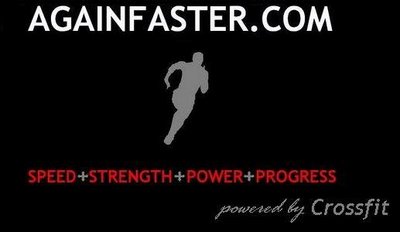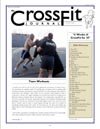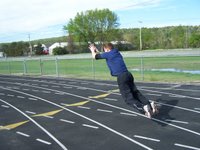Basic

The true masters of any sport engage in endless repetition. This practice turns contrived movements into automatic responses. Conscious processing is eliminated from the action sequence, and the athlete goes on autopilot.
Achieving this state of mind is critical to elite performance. In “Getting into the Optimal Performance State”, Dr. Robert M. Nideffer explains that stellar performance is predicated on outward focus—the athlete must concentrate on the external environment rather than internal thought processes.
Engaging in conscious thought during athletic endeavors can severely limit performance. Any beginning athlete can attest to this phenomenon. It manifests itself in a total and utter inability to complete complicated motor sequences. The clean and jerk becomes impossible if the athlete is trying to keep fifteen sub-movements in his/her head simultaneously.
It benefits the athlete to react on instinct rather than engage in step-by-step mapping of the movement. Toward this end, repetition is critical. As the athlete repeats a movement over and over, muscle memory forms, and the body allows a complicated sequence to follow from a single thought. Rather than “dip, drive, shrug, pull, squat, stand,” the athlete thinks “Clean!” and ends up with hundreds of pounds in the rack position.
The act of repetition is equally important for less complicated movements. The less time the athlete spends thinking, the more time he/she spends moving. This translates into better performances, whether the benchmark is repetitions, time to completion, or points scored.
In the context of Crossfit, there are a number of core movements that deserve this treatment. Among them, the squat, the pull-up, the pushup, the thruster, and the clean are paramount.
They should be practiced in a low-intensity, low-pressure environment, outside of the main workout. This allows the athlete to focus solely on technique, temporarily disregarding the competitive aspects of Crossfit.
The warm-up provides an ideal environment. A significant number of repetitions, done before each and every workout, will ingrain movement patterns rapidly. Although we preach the efficacy of constant variation, the warm-up is not the place for endless variety.
The original Crossfit Warm-up emphasizes six movements, each performed 30-45 times over the course of three rounds:
Samson Stretch
Pull-ups
Dips
Overhead Squat
Sit-up
Back Extension
This warm-up activates the entire body, using functional movements to bring the athlete up to operating temperature, thereby preventing injury.
I recommend a similar scheme with slightly fewer repetitions. The sit-up, the dip, and the back extension, while certainly useful, are very simple movements, and require relatively little practice to master.
The overhead squat and kipping pull-up are more technical movements, and therefore require more practice. Given the prevalence of the clean and the thruster in Crossfit programming, I recommend including them in the lineup as well.
The Modified Crossfit Warmup
3 rounds, 10 repetitions each:
Samson Stretch
Push-up
Sit-up
Dip
3 round, 15 repetitions each:
Pull-up
Overhead Squat
Clean
Thruster
For the weighted movements, use an extremely light load--no more than 30-40% of your 1-rep maximum. Rather than spur organic change in the body, we’re trying to encourage neurological adaptation. In this context, a heavy load is unnecessary, and will detract from subsequent workout performance.
When your movements become automatic, you’ll be able to dial up the intensity of your workouts, achieving greater metabolic benefit during each session. Use the warm-up as an opportunity to permanently incorporate important movements, and performance-oriented results are sure to follow.
Go faster!
Picture of Mike Regan courtesy of Crossfit Boston. "Getting into the Optimal Performance State" was brought to my attention by the Main Site on July 31, 2006. It's well worth the read.

The true masters of any sport engage in endless repetition. This practice turns contrived movements into automatic responses. Conscious processing is eliminated from the action sequence, and the athlete goes on autopilot.
Achieving this state of mind is critical to elite performance. In “Getting into the Optimal Performance State”, Dr. Robert M. Nideffer explains that stellar performance is predicated on outward focus—the athlete must concentrate on the external environment rather than internal thought processes.
Engaging in conscious thought during athletic endeavors can severely limit performance. Any beginning athlete can attest to this phenomenon. It manifests itself in a total and utter inability to complete complicated motor sequences. The clean and jerk becomes impossible if the athlete is trying to keep fifteen sub-movements in his/her head simultaneously.
It benefits the athlete to react on instinct rather than engage in step-by-step mapping of the movement. Toward this end, repetition is critical. As the athlete repeats a movement over and over, muscle memory forms, and the body allows a complicated sequence to follow from a single thought. Rather than “dip, drive, shrug, pull, squat, stand,” the athlete thinks “Clean!” and ends up with hundreds of pounds in the rack position.
The act of repetition is equally important for less complicated movements. The less time the athlete spends thinking, the more time he/she spends moving. This translates into better performances, whether the benchmark is repetitions, time to completion, or points scored.
In the context of Crossfit, there are a number of core movements that deserve this treatment. Among them, the squat, the pull-up, the pushup, the thruster, and the clean are paramount.
They should be practiced in a low-intensity, low-pressure environment, outside of the main workout. This allows the athlete to focus solely on technique, temporarily disregarding the competitive aspects of Crossfit.
The warm-up provides an ideal environment. A significant number of repetitions, done before each and every workout, will ingrain movement patterns rapidly. Although we preach the efficacy of constant variation, the warm-up is not the place for endless variety.
The original Crossfit Warm-up emphasizes six movements, each performed 30-45 times over the course of three rounds:
Samson Stretch
Pull-ups
Dips
Overhead Squat
Sit-up
Back Extension
This warm-up activates the entire body, using functional movements to bring the athlete up to operating temperature, thereby preventing injury.
I recommend a similar scheme with slightly fewer repetitions. The sit-up, the dip, and the back extension, while certainly useful, are very simple movements, and require relatively little practice to master.
The overhead squat and kipping pull-up are more technical movements, and therefore require more practice. Given the prevalence of the clean and the thruster in Crossfit programming, I recommend including them in the lineup as well.
The Modified Crossfit Warmup
3 rounds, 10 repetitions each:
Samson Stretch
Push-up
Sit-up
Dip
3 round, 15 repetitions each:
Pull-up
Overhead Squat
Clean
Thruster
For the weighted movements, use an extremely light load--no more than 30-40% of your 1-rep maximum. Rather than spur organic change in the body, we’re trying to encourage neurological adaptation. In this context, a heavy load is unnecessary, and will detract from subsequent workout performance.
When your movements become automatic, you’ll be able to dial up the intensity of your workouts, achieving greater metabolic benefit during each session. Use the warm-up as an opportunity to permanently incorporate important movements, and performance-oriented results are sure to follow.
Go faster!
Picture of Mike Regan courtesy of Crossfit Boston. "Getting into the Optimal Performance State" was brought to my attention by the Main Site on July 31, 2006. It's well worth the read.




















0 Comments:
Post a Comment
<< Home